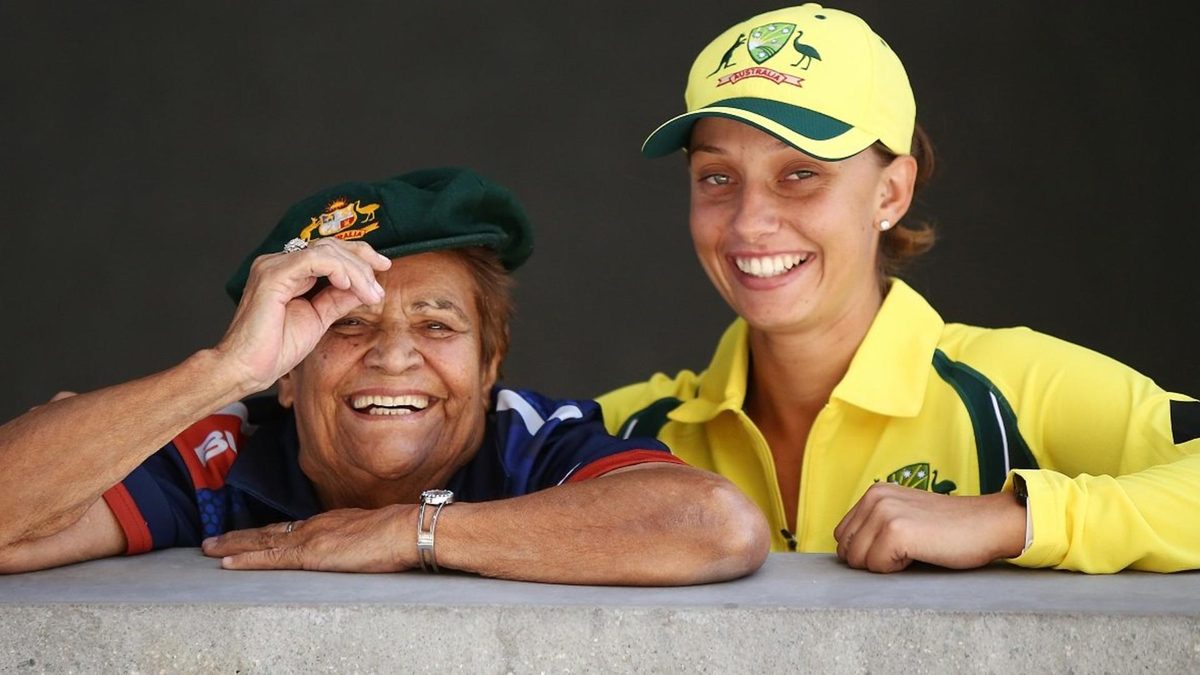
Test cricket is nearly a century and a half old, but few have traversed a route as steep as Faith Thomas before representing their nation.
Shabnim Ismail is typically credited with the fastest ball bowled by a woman… but that is only in the speed gun era. If you asked Thomas, she would tell you she was the fastest.
There is no way to validate that claim, but the Mary Duggan dismissal may be relevant here. On England’s 1957/58 tour of Australia, Faith – then Coulthard – sent the middle stump flying over over the wicketkeeper’s head during a tour match at the Gabba.
As the wicketkeeper caught the bail, the England captain sat on the pitch, laughing, for she had never seen anything of the sort. A subsequent newspaper photograph recreated the trajectory of the ball.
If not the fastest of all time, certainly the fastest of her time.
On the same tour, Faith became the first indigenous Australian to play Test cricket – or any sport, for that matter – for the nation, that too “in an era when administrators regarded women’s cricket as an embarrassment”. Yet, that is only part of her story.
Faith was born in 1933, roughly at a time when Eddie Gilbert, the great indigenous fast bowler, was bothering Don Bradman & co. in the Sheffield Shield and threatening to break into the Test side. A suspect action would later prevent him.
At this point, the Australian government had a policy that enabled them – or churches or welfare organisations – to forcibly take the children from indigenous Australian families and give them away to non-indigenous families or institutions.
Colebrook Home, then based just outside Quorn, South Australia, was one of these institutions. This was where Faith’s mother Ivy left her when she was three months old.
“Mum did not abandon me. There was no support for her at that time. A single woman, Mum had just given birth and her only way of earning a living was working in hotel kitchens,” Ashley Mallett quoted her in The Boys From St Francis.
In 1934/35, England toured Australia for the first ever women’s Test matches. In the tour match against Queensland, they faced two indigenous Australian cricketers, Mabel Campbell and Edna Crouch, but that was an aberration. The nearest to cricket they had at Colebrook were games with sticks and stones.
In a few years’ time, Faith was hurling stones to bring down galahs, a breed of cockatoos, from the sky. “You didn’t need to take a run-up to knock a galah out of the sky. You just picked up a rock and let it fly,” she would later tell. Over the years, she would hurl slingshots at express pace off a six-step run-up, often taking the batters by surprise.
But when she was growing up, no one at Colebrook had cricket in their vision. The priority was to find a proper job. In 1950, the indigenous Lowitja O’Donoghue joined as a nurse in Victor Harbor, inspiring four residents of Colebrook to follow the same path.
Faith had already been working at Lush Studios at this point. She merely decided to tag along with her friends to the Royal Adelaide Hospital. “Nurse your own people,” was the matron’s response, who insisted they returned to Alice Springs.
Faith’s mind was made up: “I’ll chuck my commercial art job and go with this mob.” It was not easy, but she did become a nurse. Not too long afterwards, her colleague Fay Beckworth would tell her about cricket practice. She decided to join.
At this stage, she had no knowledge of how to swing the ball, or even the names of the fielding positions, but as she practised, her raw pace set her apart from her peers. For Windsor, she soon completed a hat-trick, and in another match, took 6-0 against the Adelaide Teachers’ College Team.
Former Australian Test captain Vic Richardson noticed her, and advised her to lengthen her run-up (“you’ll rip your cartilage to pieces”) – something that would help her to bowl even quicker.
But that was not the only thing that made her put in extra effort behind her bowling. Roughly around this time, the song freight train used to be a regular chart-topper. ‘Freight train’, the opposition would call her – a racist remark, referring to her complexion and large frame.
“It had the reverse effect,” Faith told Mallett. “It resulted in things flying everywhere. I got my ire up a bit and bowled faster and more accurately than I thought I could.”
In 1955/56, she claimed 9-15 against a touring New Zealand side for South Australia. Two years later, she became the 48th woman to play Test cricket for the country. She was excellent at hockey and squash as well.
She played until 1960. In her final club game, she walked out, eight months pregnant, her “guts sticking out”. She requested the opposition bowlers to not hit her on the belly. When they bowled slow, she “just stood there and hit them all over the place.”
Her sporting career faded out as abruptly as it rose, but not before she had fought battles on two grounds – gender and race – to become a cricket star, while pursuing a nursing career.
Over the years, she travelled the lengths and breadths of the vast country to make life better for indigenous Australians.
In 1997, she was honoured with the Aboriginal and Torres Strait Islander Sports Lifetime Achievement Award. In 2019, she was handed the Order of Australia.
In 2021, the Adelaide Strikers announced that they would compete with Perth Scorchers at the WBBL for the Faith Thomas Trophy to celebrate ‘Aunty Faith’.








